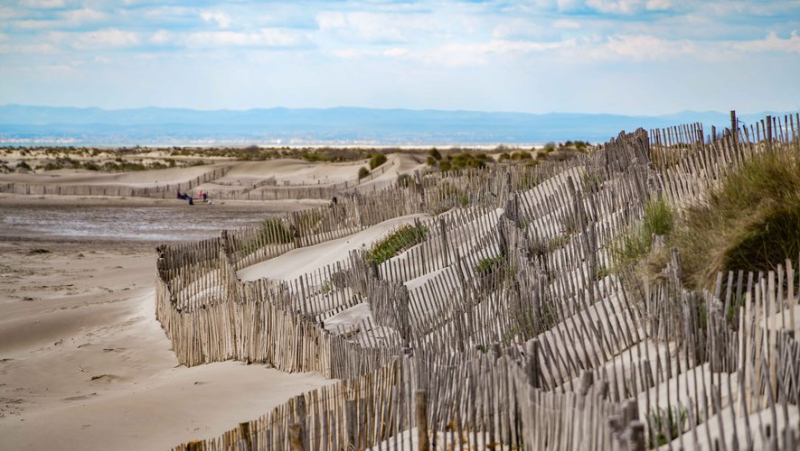Protection of the coastline: in Grau-du-Roi, anticipation is the key word in the face of rising water levels

Le cordon dunaire des Baronnets, où des travaux de restauration se sont achevés en avril dernier. Midi Libre – MiKAEL ANISSET
Face à l'augmentation inéluctable du niveau de la mer, le point sur les dispositifs et les perspectives au Grau-du-Roi.
This is not a discovery, the effects of climate change have consequences on our coastline. According to the Intergovernmental Panel on Climate Change (IPCC), while, since the 1900s, the average sea level has increased by approximately 20 cm, several scenarios are being considered. ;here at 2100.
An inevitable rise in sea levels
"The most optimistic, which corresponds to the Paris agreements, considers that if the increase in temperature, compared to the pre-industrial era, is limited to + 1.5 °C then the associated sea level rise will be + 38 cm in 2100, recalls the mayor of Grau-du-Roi, Robert Crauste.The median scenario estimates that if the temperature increase is +3 deg C, then the associated sea level will rise by 56 cm in 2100. This scenario is very close to the current scenario which predicts, without changing current policies, a warming of +2.8 deg C. Finally, the most pessimistic, for his part, estimates that if the temperature rise is + 4.4°C then the associated sea level will rise by 77 cm in 2100."
Predictions which, in any case, do not encourage optimism and encourage elected officials to take action and anticipate. "This evolution is the consequence of both the thermal expansion of the oceans and the melting of terrestrial glaciers and ice caps. These phenomena are directly linked to the increase in temperatures, themselves caused by the increase in the concentration of CO2 in the atmosphere. Rising water levels are also likely to accelerate erosion mechanisms, encourage a retreat of the coastline and increase the frequency of episodes of marine submersion. These two natural processes have always existed in the territory of the Greater Rhône Delta, notes Robert Crauste, first vice-president of the national association of coastal elected officials, who makes no secret of not the inevitability of rising sea levels and, therefore, the political obligation to deal with it.
"The Grau-du-Roi will no longer expand"
For the mayor of Grau-du-Roi, the first evidence is: "The city will expand further. The urban area of Grau-du-Roi is strictly limited to its current envelope which represents less than 10% of the municipal territory, underlines Robert Crauste, who adds that < em>"the coastline of Grau-du-Roi, when observed from the 1950s to the present day is
generally stable according to the IGN website "Rewind time". Although there is no retreat of the coastline to date, we note, however, two points of erosion and significant accretion (*)& ;quot;.
Citing thus, for the accretion phenomenon, the sandy spit of Espiguette. "The southern beach takes on a character lagoon like the north beach. This site has become a leisure spot but it is also a spot of biodiversity and the search for a balance must be engaged, believes Robert Crauste who presses the means that this sandbank also plays a protective role for Port-Camargue and Grau-du-Roi during southeast storms.
D’accretion in erosions
Erosion, for its part, is monitored on the Baronnets side, at Espiguette and, to the west at Boucanet, before the Abîmes pass which separates the Gard and Hérault. "Aux Baronnets, the town has established a defense system against marine submersion based on the model of nature-based solutions with a second-rank dune cordon which has just been reinforced . This device works, assures the chosen one,but it must be modeled for 2040 and 2100 in order to anticipate its adaptations. In Boucanet, a project validated by the State is currently suspended due to opposition from the owner of a private establishment. What we can regret. I am not losing sight, personally, of a change in State doctrine in order to authorize a breakwater type protection structure with public-private financing."
Capelude groynes, reinforced second-tier dune cordon, large southern dike at Port Camargue, groynes on the southern and northern beaches, damming of the marina, left bank breakwater, moles of’ entrance to the fishing port Right bank and left bank recently rebuilt or even Boucanet wedging groynes… if protection systems exist, the first vice-president of the national association of coastal elected officials wants to go further: "We demand with the president Yannick Moreau, mayor of Sables-d’Olonne, national solidarity with the creation of a fund to support our territories to finance useful protection work and adaptations.
Adaptation is the key word. In the time that opens up to us, we must project ourselves to 2040 and 2100 and certainly beyond, but we will admit that it is not simple…" By these deadlines, a study for the mapping of the Grau-du-Roi coast line has just been launched.
(*) Accretion is the process of agglomeration of inorganic, solid or fluid elements.




